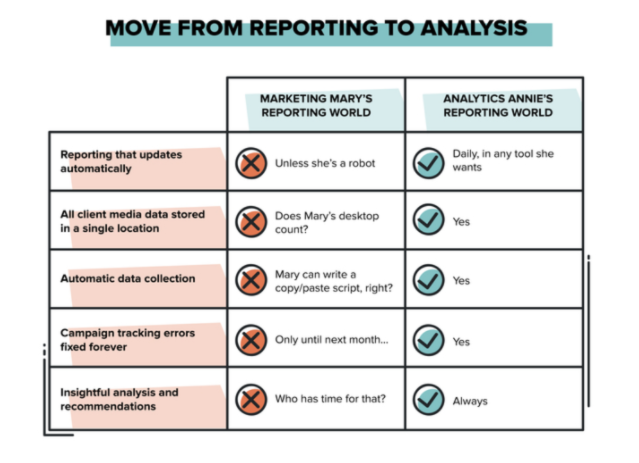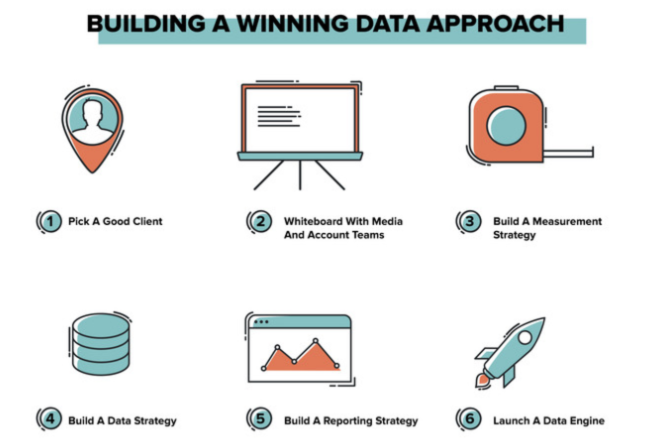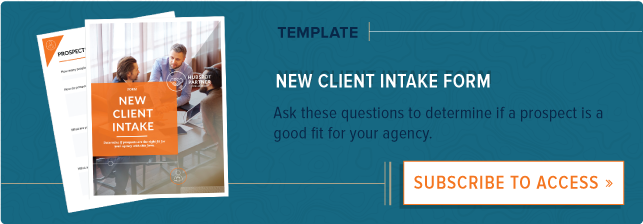
Love it or hate it, data is essential to any agency professional's existence.
And where there's data, there's reporting. Marketers can’t and (shouldn’t) avoid reporting, so they have to increasingly become proficient with it.
As clients have become more knowledgeable and demanding about reporting, their analysis and insights expectations have become higher. This adds additional stress to agency teams trying to manage more data, more frequently, and from more media sources. 
Data analysis can often seem like a painful burden, and marketers today are either avoiding it, or going crazy trying to make sense of the data overload by purchasing reporting tools to solve their problem.
This leads us to wonder how the Marketing Marys and Analytics Annies of the agency world are solving their own marketing data reporting problems. With the sheer number of data sets to analyze, decipher and review, the life of marketing reporting analyst is becoming ever more complex.
So how are agencies approaching this data problem? Let’s take a look at a day in the (reporting) life of Marketing Mary and Analytics Annie, each responsible for client reporting at their respective agencies.
The Story of Two Marketers
It’s the first day of the month and Marketing Mary is starting the “Data Death March:" the painful task of manually gathering media channel data for month-end client reporting. This can take days -- sometimes weeks of effort -- only to spit out a basic report recapping what happened last month that the client will hopefully read.
For Analytics Annie, the first day of the month is no different than any other day. She opens a client report (automatically refreshed with current media results), begins to analyze performance and develops timely, insightful recommendations to share with her client.
Annie’s reports aren’t just a spreadsheet of numbers -- they are factual bits of information organized in an easy-to-read report that shows not only the state of the union -- but what and how to improve their marketing efforts.
Data First, Then Reporting
So what’s the difference between Marketing Mary and Analytics Annie? Many might say Analytics Annie has a fancy data visualization tool to make her reporting automated. And they may be right -- or she could actually just be looking at a report in Excel.
The real reason Analytics Annie is able to spend her time on impactful analysis for her clients has nothing to do with her reporting tool of choice. It's because she solved her underlying media data collection problem by way of automation.
Mary, at some point, likely succumbed to using a data visualization tool for her reporting that promised all the bells and whistles. It looked good, seemed simple to use, and was going to take all the pain away to allow her agency to make reporting for all her clients effortless.
But the tool wasn’t even collecting the necessary data to begin with. The challenge Mary was facing wasn’t a tool problem, it was a data problem. Without having the underlying data in a usable format to begin with, she was still manually gathering and preparing her media data, leaving no time for analysis.
She put too much faith in the tool to solve her reporting problems that in the end, all she had was prettier dashboards, but not better or faster ones.
Because Annie knew that she had to solve her data collection problem first, it made finding the right reporting tool much easier to justify and use, freeing up her time for analysis.
A Single Source of Truth
Solving the underlying media and marketing data aggregation problem is both simple and complex. The simple part? You need one single location (like a data warehouse or a marketing data management platform) to store all of your media data together.
The hard part? Automating the data collection into the warehouse, building relationships between the disparate data sources, cleaning up jacked campaign tracking parameters and maintaining the integrity and accuracy of the data.
A few agencies with large teams dedicated full-time to managing the agency’s data platform can do it in house using a data warehouse, like Amazon Redshift. If you do it yourself, you need to input the data in an automated fashion. Typically this will happens in two ways:
APIs are usually preferred, but not all source systems have APIs. Often times, they simply aren’t very good. In other cases, some data (like TV buys) lives in files instead of in a system.
Most agencies, however, run very lean and instead rely on external marketing data management platforms. These platforms already have all the API and ETL connections in place so that agencies are able to authenticate their media sources and get access to their consolidated data very quickly.
Move from Reporting to Analysis
Regardless of the solution, the Marketing Marys of the world can reduce their reporting prep time by up to 90% once they fix their data collection problem.
A marketer's time shouldn’t be spent collecting the information, or even reporting on it. It should be spent using that information to optimize their marketing efforts and increase gains (achieving goals).
That’s why Analytics Annies are the stars of the marketing world. They have the time to dive into the meaning of the data, develop insightful recommendations and do actual analysis, not just build reports. Analytics Annies are so successful in their role because they:
- Automatically update their reporting nightly.
- Optimize budgets across all channels with clear attribution modeling.
- Consolidate their offline and online media performance to a single chart.
- Roll up all their agency-wide metrics into a single holistic view.

Using History to Drive Planning
When you fix your agency’s approach to data and integrate all media channel data for all clients in one single location, the agency’s ability to drive data-driven media planning and forecasting exponentially increases.
For Mary, client media planning revolves around crawling through monthly presentations, tracking down historical spreadsheets from different team members, and pulling an all-nighter in a conference room with bad takeout food to piece together some sort of educated plan for the client -- only to know that this exercise is the first of many to come.
For Annie however, simply accessing her single source of truth to analyze all media performance over a number of years, visualize media mix patterns and changes, and aligning these patterns to spend and performance, happens dynamically within a few minutes.
Not only does this approach yield real data-driven planning grounded in accurate data, Annie is spared the heartburn and fatigue from the all-nighter and greasy takeout food.
Building a Winning Data Approach
In this scenario, Marketing Mary represents what most agencies are struggling with today. In fact, I think it is safe to say that most agencies have historically treated analytics as a means to justify their strategies and tactics. This lack of focus has created thousands of exhausted Marketing Marys everywhere in the agency industry.
To fix the marketing data problem, agencies need a data engine and a solid analytics strategy. The steps below are a good place to start:

- Pick a “good” client that utilizes the majority, if not all, of the data systems used to support their media strategy.
- Gather the account and media teams that support this client around a whiteboard.
- Build a measurement strategy. The teams should work together to review/develop the key performance indicators (KPIs) needed to demonstrate value for this client.
- Build a data strategy. Identify all of the data systems that contain the key data metrics needed to support the measurement strategy and make a list for each system.
- Build a reporting strategy. In a single page dashboard, mock-up a report design of what the elements would be to demonstrate the value of the campaign.
- Launch a data engine. Implement a process to bring all of this data together into a single source to enable the use of any reporting/data visualization tool to make these strategies come to life.
While I have used this recipe for success for the past ten years, success ultimately begins with a change in thinking and a desire to have your agency operate like Analytics Annie. Without this desire and commitment, the agency simply won’t be successful in analytics long-term.
from HubSpot Marketing Blog https://blog.hubspot.com/marketing/agency-data-approach

No comments:
Post a Comment